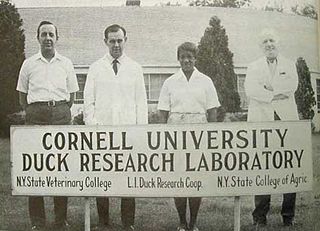Related Research Articles

Psittacosis—also known as parrot fever, and ornithosis—is a zoonotic infectious disease in humans caused by a bacterium called Chlamydia psittaci and contracted from infected parrots, such as macaws, cockatiels, and budgerigars, and from pigeons, sparrows, ducks, hens, gulls and many other species of birds. The incidence of infection in canaries and finches is believed to be lower than in psittacine birds.

Erysipelothrix rhusiopathiae is a Gram-positive, catalase-negative, rod-shaped, non-spore-forming, nonacid-fast, nonmotile bacterium. Distributed worldwide, E. rhusiopathiae is primarily considered an animal pathogen, causing the disease known as erysipelas that may affect a wide range of animals. Pigs, turkeys and laying hens are most commonly affected, but cases have been reported in other mammals, birds, fish, and reptiles. In pigs, the disease is known as diamond skin disease. The bacterium can also cause zoonotic infections in humans, called erysipeloid. The human disease called erysipelas is not caused by E. rhusiopathiae, but by various members of the genus Streptococcus.
Avian infectious bronchitis (IB) is an acute and highly contagious respiratory disease of chickens. The disease is caused by avian infectious bronchitis virus (IBV), a coronavirus, and characterized by respiratory signs including gasping, coughing, sneezing, tracheal rales, and nasal discharge. In young chickens, severe respiratory distress may occur. In layers, respiratory distress, nephritis, decrease in egg production, and loss of internal and external egg quality are reported.
Avian coronavirus is a species of virus from the genus Gammacoronavirus that infects birds; since 2018, all gammacoronaviruses which infect birds have been classified as this single species. The strain of avian coronavirus previously known as infectious bronchitis virus (IBV) is the only coronavirus that infects chickens. It causes avian infectious bronchitis, a highly infectious disease that affects the respiratory tract, gut, kidney and reproductive system. IBV affects the performance of both meat-producing and egg-producing chickens and is responsible for substantial economic loss within the poultry industry. The strain of avian coronavirus previously classified as Turkey coronavirus causes gastrointestinal disease in turkeys.
Marek's disease is a highly contagious viral neoplastic disease in chickens. It is named after József Marek, a Hungarian veterinarian who described it in 1907. Marek's disease is caused by an alphaherpesvirus known as "Marek's disease virus" (MDV) or Gallid alphaherpesvirus 2 (GaHV-2). The disease is characterized by the presence of T cell lymphoma as well as infiltration of nerves and organs by lymphocytes. Viruses related to MDV appear to be benign and can be used as vaccine strains to prevent Marek's disease. For example, the related herpesvirus found in turkeys (HVT), causes no apparent disease in the birds, and continues to be used as a vaccine strain for prevention of Marek's disease.

Gallid alphaherpesvirus 1 (GaHV-1) is a species of virus in the order Herpesvirales, family Herpesviridae, subfamily Alphaherpesvirinae, and genus Iltovirus. Originally recognised in chickens in the United States in 1926, this virus causes avian infectious laryngotracheitis, a potentially fatal, economically deleterious disease, widely recognised as one of the most contagious diseases in the poultry industry. The virus and its associated disease also occur in pheasants.
The University of Georgia College of Veterinary Medicine is a college within the University of Georgia (UGA) in Athens, Georgia, United States and is a top 10 ranked veterinary school.
Emil Raphael Unanue was a Cuban-American immunologist and Paul & Ellen Lacy Professor Emeritus at Washington University School of Medicine. He is a member of the National Academy of Sciences, the American Academy of Arts and Sciences and the Institute of Medicine. He previously served as chair of the National Academy of Sciences Section of Microbiology and Immunology.
Avian orthoreovirus, also known as avian reovirus, is an orthoreovirus from the Reoviridae family. Infection causes arthritis and tenosynovitis in poultry. It can also cause respiratory disease.
Robyn Gwen Alders AO is the first female veterinary scientist to be made an Officer of the Order of Australia. Dr. Alders is most recognised for her work on food security by improvements in poultry health in developing countries. Alders' work on the maintenance of the health of small poultry flocks helps under-resourced women to provide adequate nutritional and financial support for their families.

Jessie Isabelle Price was a veterinary microbiologist. She isolated and reproduced the cause of the most common life-threatening disease in duck farming in the 1950s and developed vaccines for this and other avian diseases. A graduate of Cornell University, where she gained a PhD (1959), she worked first at the Cornell Duck Research Laboratory and later at the USGS National Wildlife Health Center. She served as chair of the Predoctoral Minority Fellowship Ad Hoc Review Committee of the American Society for Microbiology (ASM), and as president of Graduate Women in Science.
Infectious coryza is a serious bacterial disease of chickens, which affects respiratory system, and it is manifested by inflammation of the area below the eye, nasal discharge, and sneezing. The disease is found all over the world, causing high economic losses, which are due to stumping off and reduction of egg production in case of laying chickens. The disease was discovered early 1930s by considering clinical signs.
Clostridium colinum is a Gram-positive, anaerobic and spore-forming bacterium from the genus Clostridium which has been isolated from a chicken. Clostridium colinum can cause ulcerative enteritis in chicken.
Gopal Dhinakar Raj is an Indian veterinary scientist, an academic and the project director of the Translational Research Platform for Veterinary Biologicals, a partnership program between the Department of Biotechnology and the Tamil Nadu Veterinary and Animal Sciences University. Known for the development of diagnostic test kits for animal and poultry diseases such as Leptospirosis and Egg drop syndrome, Raj is a member of the DBT Task Force on Animal Biotechnology. The Department of Biotechnology of the Government of India awarded him the National Bioscience Award for Career Development, one of the highest Indian science awards, for his contributions to biosciences in 2007.

Gao Fu, also known as George Fu Gao, is a Chinese virologist and immunologist. He served as Director of the Chinese Center for Disease Control and Prevention from August 2017 to July 2022 and has been Dean of the Savaid Medical School of the University of Chinese Academy of Sciences since 2015.

David Lee Suarez, DVM, PhD, ACVM is a virologist and immunologist.
Vaccine resistance is the evolutionary adaptation of pathogens to infect and spread through vaccinated individuals, analogous to antimicrobial resistance. It concerns both human and animal vaccines. Although the emergence of a number of vaccine resistant pathogens has been well documented, this phenomenon is nevertheless much more rare and less of a concern than antimicrobial resistance.

Airsacculitis, also known as air sacculitis, aerosacculitis, air sac disease, air sac infection, air sac syndrome and simply sac disease, is a common inflammatory condition of air sacs that occurs in birds and is caused by various microbial taxa. Having multiple different causative agents, the condition is widely distributed around the world.

De’Broski. R. Herbert is an immunologist, parasitologist, academic, and biomedical researcher. He is currently Full Professor of Immunology, and Penn Presidential Professor at the University of Pennsylvania School of Veterinary Medicine. He is also the Associate Director for Institute of Infectious and Zoonotic Disease (PennVet), and an affiliated Scientist at the Monell Chemical Senses Center.
India NAP Gail Houston Cassell is an American microbiologist whose research focuses on Mycoplasma species and multidrug-resistant tuberculosis. She is vice president of TB drug development at the Infectious Disease Research Institute. In 1994 she was the president of the American Society for Microbiology (ASM).
References
- ↑ "John E. Dohms Ph.D. Obituary: View John Dohms's Obituary by The News Journal". Legacy.com. Retrieved 2014-04-18.
- ↑ Quartararo, Elizabeth. "Missing since 2012, professor remembered by friends and relatives", The Review, March 3, 2014. Accessed May 10, 2016. "Bernard Kaplan, a university English professor who has known Dohms since they were both children growing up a block away from each other in Fair Lawn, N.J., said shortly after Dohms’ disappearance, he traveled to their hometown to pass out flyers and let neighbors know to look out for him."
- ↑ Dohms, John Edward; Saif, Y. M. (1977). Studies on the metabolism and passive transfer of immunoglobulins in the domestic turkey (Thesis).
- ↑ Diseases of Poultry. John Wiley & Sons. 16 November 2011. pp. 31–. ISBN 978-1-119-94950-3.
- ↑ "Archived copy" (PDF). Archived from the original (PDF) on 2011-12-02. Retrieved 2015-04-12.
{{cite web}}: CS1 maint: archived copy as title (link) - ↑ Key1971. ScholarWorks@BGSU.
- ↑ Gerace, Frank. "WDEL 1150AM - Missing man's brother asks for public's help". Wdel.com. Retrieved 2014-04-18.
- ↑ Simmons, Karie (2014-03-01). "Skeletal remains identified as missing former professor - Newark Post: News". Newarkpostonline.com. Retrieved 2014-04-18.
- ↑ "In memoriam; Friends, colleagues remember Prof. John Dohms", UDaily, March 7, 2014. Accessed July 16, 2018. "Born in New York City, Dr. Dohms graduated from Fair Lawn High School in New Jersey in 1966."